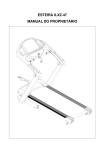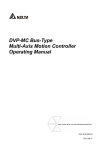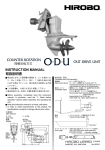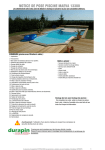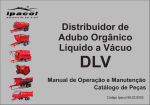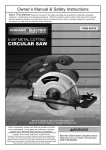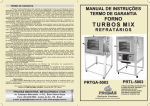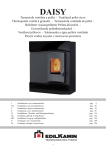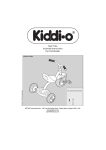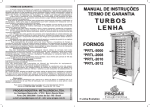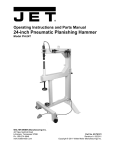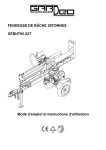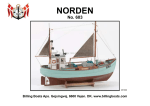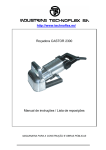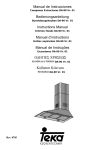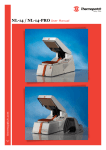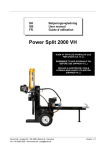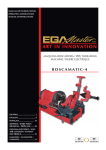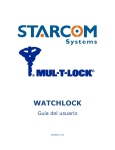Download servicing instructions - Mul-T-Lock
Transcript
Table of Contents Introduction............................................................................................4 Classic. .................................................................................................4 Interactive®........................................................................................10 7X7®.....................................................................................................14 Integrator®.........................................................................................18 Solid plug pins.................................................................................22 Side/back pins..................................................................................26 "3-IN-1" cylinder type.....................................................................28 Modular cylinder type....................................................................32 Servicing & Assembly ..............................................................35 Thumbturn cylinder type...............................................................35 Thumbturn cylinder assembly instructions............................37 Modular cylinder assembly instructions. ................................40 "Spring Catcher" and "Filed Key" servicing instructions...................................................................46 "Follower" for single cylinders servicing instructions.......50 "Sliced Follower" for double cylinders servicing instructions....................................................................53 Master keying.....................................................................................57 Introduction.......................................................................................57 Design methods...............................................................................60 Work flow of master key system................................................63 Design options profiles and keys..............................................67 General notes. ..................................................................................68 Introduction Introduction Classic Basic cylinder construction and structure Mul-T-Lock cylinders are built and operate on the basic principles of a standard pin tumbler lock mechanism. A plug, rotating within a shell, turns a tail/cam/gear when pins of various lengths are aligned at a shear line by means of a key. All pins must be elevated to the shear line simultaneously before the plug can turn within the shell. Mul-T-Lock high-security cylinders have an added unique telescopic pin tumbler mechanism with internal and external pins. Both the internal and the external shear lines must be aligned simultaneously in order for the plug to rotate. This dual-locking principle and other patented features contribute to Mul-T-Lock’s high number of different combinations, master keying capability, and extreme pick resistance. The standard product has five chambers, containing 10 plug pins and 10 body pins. Mul-T-Lock cylinders are also protected against various forms of physical attack by hardened drill-resistant inserts within the shell and the plug, which protect the shear line. When master keyed, additional side pins or back pins can be incorporated to allow even greater control and flexibility. Chamber stopper External body spring External body pin Internal body spring Internal body pin Master keying pin Cylinder body Internal plug pin External plug pin Plug Key Classic Introduction Pinning concept Mul-T-Lock high security cylinders have a unique telescopic pin tumbler mechanism with internal and external pins. Both the internal and the external shear lines must be aligned simultaneously in order for the plug to rotate. Internal plug pin External plug pin Double shear line Internal body pin Internal body spring External body pin External body spring Three-dimensional shear line The Mul-T-Lock patented plug has a unique structure. When the top and bottom pins, plug and body meet, a three-dimensional shear line is formed in an almost perfect spherical shape. Classic Introduction Classic key Mul-T-Lock keys contain five double dimple cuts to provide two combinations in each chamber: internal and external. Internal combination External combination 4.8 4.8 4.8 4.8 5.3 The cuts are numbered from bow to tip, from 1 to 5. The distance from the tip, which is also the key stop, to the center of the fifth cut is 5.3 mm for both Left Hand (LH) and Right Hand (RH) keys. The spacing (distance from center to center of each cut) is 4.8 mm. When the cylinder has 4, 3 or 2 chambers, the first cuts are omitted from the cylinder. The key always has all five cuts so that it can fit other products within a keying system. Classic Introduction Key hand groups Mul-T-Lock keys are divided into two major groups according to their profiles: Right Hand (RH) and Left Hand (LH). To determine the key hand, hold the key head with the tip pointing upwards. If the cuts and/or milling appear on the right, this is a Right Hand key. If the cuts and/or milling appear on the left, this is a Left Hand key. Left Hand profile Key depth measuring system Right Hand profile Y X As in ordinary keys, Mul-T-Lock key cuts are measured from the base (back) of the key to the bottom of the cut. This means that the remaining material of the key, after cutting is what is actually measured. Classic Introduction Systems components Solid master disk # 3 Solid master disk # 2 External master disk # 3 External master disk # 2 ternal master disk # 3 Internal master disk # 24 Solid Solid master master disk disk # 3# 1 Solid master disk # 2 External Externalmaster master disk disk##13 External master disk # 2 Internal master disk # 13 Solid Solid master master diskdisk # 3# 1 Solid master disk # 2 External Externalmaster master disk disk# #1 3 Internal Internal master master Internal Internal master master disk disk ## 24 disk disk ## 13 Solid ma disk # External master disk # 2 Internal master disk # 24 Internal master disk # 13 Classic Exte Inte Plug pins Material: Nickel silver. Structure: Externals are built in a tube shape, to hold the internals within. Introduction Pins specification Diameter: 4 mm for externals; 2 mm for internals. Patented combines pins (body, driver pins) Material: Nickel silver for pins, stainless steel for spring B A 1 2 D C 3 4 5 Length: Varies according to product size Standard 22 mm 19 mm Classic Introduction Interactive® Interactive cylinder construction and structure The Mul-T-Lock patented Interactive system raises security levels to new heights. The Interactive system combines the unique telescopic pin tumbler mechanism and special features of the Mul-T-Lock Classic system with a spring-loaded pin in the cylinder plug, to produce a ‘virtual combination’, which is possible only when the key is inserted in the lock. To achieve an even higher level of key security, Interactive patented keys and key blanks provide increased control over key cutting. Additional keys can be cut only after presentation of a Mul-T-Lock key registration card and verification of the customer’s identity. Interactive Technology is retro-compatible with the Mul-T-Lock Classic system, allowing existing locks to be upgraded. The standard product has five chambers, containing 10 plug pins and 10 body pins. Interactive Cylinders are also protected against various forms of physical attack by hardened drill-resistant inserts within the shell and the plug, which protect the shear line. When master keyed, additional side pins or back pins can be incorporated to allow even greater control and flexibility. Chamber stopper External body spring Cylinder body Internal body spring External body pin Master keying pin External plug pin Internal body pin Internal plug pin Plug Interactive plug pin Interactive pin Interactive Key 10 Interactive Introduction Pinning concept The Mul-T-Lock patented Interactive cylinder adds two new pins to the assortment of code pins. The new pins are shorter than the ones used before in the Classic line. They actually work above the ‘blank level’, creating a virtual combination, which can be raised to the shear line only by using a Mul-T-Lock Interactive patented key. The Interactive chamber may be located in the first or second chamber, and can be A0, Z0, or Z1. Interactive key Interactive plug pin Interactive pin Interactive key Virtual combination Internal plug pin External plug pin Double shear line Internal body pin Internal body spring External body pin External body spring Interactive pin The keys in the Interactive series are cut in the same way as Classic keys, with a slight difference. It is only necessary to cut four positions, because the fifth position – the Interactive pin – has already been embedded at the factory. The interactive key will contain one of the following cuts – A0, Z0, Z1 – which has been embedded into it during the manufacturing process. Interactive 11 Introduction Systems components Solid master disk # 3 Solid master disk # 2 External master disk # 3 External master disk # 2 ternal master disk # 3 12 Internal master disk # 24 Solid Solid master master disk disk # 3# 1 Solid master disk # 2 External Externalmaster master disk disk##13 External master disk # 2 Internal master disk # 13 Solid Solid master master diskdisk # 3# 1 Solid master disk # 2 External Externalmaster master disk disk# #1 3 Internal Internal master master Internal Internal master master disk disk ## 24 disk disk ## 13 Solid ma disk # External master disk # 2 Internal master disk # 24 Internal master disk # 13 Interactive Exte Inte Two additional pin lengths have been added to the Mul-T-Lock re-keying kits: • External pin Z (which is 0.5 mm shorter than the A pin) Introduction Pins specification • Internal pin 0 (which is 0.5 mm shorter than the 1 pin) The Interactive line of products differs from other Mul-T-Lock products in two ways: a. The Interactive pin is embedded in the patented key during the manufacturing process b. The spring loaded pin embedded in the plug in the first or second position Plug pins Material: Nickel silver Structure: Externals are built in a tube shape, to hold the internals within Diameter: 4 mm for externals; 2 mm for internals Z 0 Interactive A 1 B 2 C 3 D 4 5 13 Introduction 7X7® 7x7 cylinder construction and structure Mul-T-Lock 7X7 is single pin tumbler mechanism, operating on a flat dimple cut key. The pins and keys are made of nickel silver. A plug, rotating within a shell, turns a tail or cam when pins of various lengths are aligned at a shear line by means of a key. The 7X7 key system standard product comes with seven chambers, seven plug pins, and seven body pins. Chamber stopper Body spring Body Mushroom body pin Body pin Mushroom Plug pin Master keying pin Plug Plug pin Key 14 7X7® Introduction Pinning concept Mul-T-Lock 7X7 security cylinders have a pin tumbler mechanism. Pins must be aligned to shear lines in order for the plug to rotate. Plug pin Shear line Body spring Body spring 7x7 key Mul-T-Lock 7X7 keys contain seven dimple cuts. The cuts are numbered from bow to tip, from 1 to 7. The distance from the tip, which is also the key stop, to the center of the fifth cut is 4.9 mm. The spacing (distance from center to center of each cut) is 3.4 mm. 3.4 3.4 3.4 3.4 3.4 3.4 4.9 When the cylinder has two, three, or four chambers, the first cuts are omitted from the cylinder. The key always has all seven cuts so that it can fit other products within a keying system. 7X7® 15 Introduction Key depth measuring system As in ordinary keys, Mul-T-Lock 7X7 key cuts are measured from the base (back) of the key to the bottom of the cut. This means that the remaining material of the key, after cutting is what is actually measured. X Master components 1 2 3 4 5 Pinning Abbreviations 16 2 Master Disk #2 4 Plug Pin #4 7X7® Introduction Pins specification Plug pins Material: Brass/nickel silver 1 2 3 4 5 6 Body, driver pins Material: Brass/nickel silver. Length: Varies 7X7® 17 Introduction Integrator® Integrator cylinder construction and structure The Mul-T-Lock patented (and patent pending) Integrator system provides the added advantage of a patented protection to key security. The specially designed Integrator pin adds a new dimension to the 7X7 line. For the purposes of master keying, this new dimension can be used for creation of hierarchical levels. The Integrator patented keys and key blanks provide increased control over key cutting. Additional keys should only be cut after presentation of a Mul-T-Lock key registration card and verification of customer identity. The Integrator technology is retro-compatible with the Mul-T-Lock 7X7 system, allowing existing locks to be integrated into one system with Integrator cylinders. The Mul-T-Lock Integrator standard product has seven chambers, seven plug pins and seven body (driver) pins. Chamber stopper Body spring Body Body pin Master keying pin Integrator Plug Integrator plug pin Integrator Spacial Grove Integrator Key 18 Integrator® The Mul-T-Lock patented Integrator cylinder adds two new patented plug pins to the standard specification 7X7 code pins. The special three-dimensional structure of the plug pin ensures that only Integrator keys are capable of achieving the shear line. Integrator Spacial plug pin Integrator Oval chamber Introduction Pinning concept Integrator Key The Integrator chamber may be located in one of seven positions. Integrator “M” type key cut in Integrator cylinder chamber Integrator® 7X7 key cut in Integrator “M” type cylinder chamber Integrator “M” type key cut in 7X7 cylinder chamber 19 Introduction Integrator key M-Master cut The keys in the Integrator series are cut in the same manner as Mul-T-Lock 7X7 keys, with a slight difference. You only need to cut six positions since the seventh position, the Integrator pin combination, has been pre-cut in the key during the manufacturing process. E-External cut P-Internal cut The Integrator key will contain one of the following cuts: M-Master cut E-External cut P-Internal cut Key systems – Integrator & 7x7 system hierarchy Integrator Type M Patented Level Integrator Type E Integrator Type P 7X7 20 Integrator® The following pins have been added to the Mul-T-Lock 7x7 re-keying kits: - Double Launcher pin for M-type keys. - Single Launcher pin that can be used for internal or external combination. Introduction Pins specification Plug pins Material: Brass/nickel silver 1 2 3 4 5 6 Double launcher pin Material: Brass/nickel silver Single launcher pin Material: Brass/nickel silver Body pins (driver pins) Material: Brass/nickel silver Integrator® 21 Introduction Solid plug pins Introduction, basic construction This revolution in master keying concept is only available in telescopic pin tumblers. An explanation in one brief sentence: we took the “multiple shear line” away from the plug shear line and moved it into the key side! By doing this we increased the reliability of a master keyed cylinder, while the system performance and possibilities goes up! The core of the approach is “merging” some sets of telescopic pins, and by doing so we obtained 15 pins that will be added to the Master keying kits. Benefit of the concept • The mechanical reliability of master keyed cylinder is enhanced because there are now fewer parts in each chamber. • The security of master key systems to “lockout” of unauthorized keys is always achieved with the external plug pin. • Ease of assembly – parts are larger than previously. • The ability to solve complex cross keying challenges is improved. Pin categories The pins can be divided into three categories a. Pins that will “ride” on the external cut are identified by a letter followed by a (-) sign. ZABCD- 22 Solid plug pins Cylinder: CKey: C4 Cylinder: CKey: C3 b. Pins that will “ride” on both external and internal, at the same time – or on the shallower of the two. They will be marked by double letter Introduction Looking at a pin “C-” in the below diagram shows that a chamber containing this pin can only be opened by one of three cuts: C4, C3, C2. Cylinder: CKey: C2 ZZ AA BB CC DD Looking at the dual letter pin BB in the above diagram, shows that it will work without any problem with a B3, B2, or C2. Cylinder: BB Key: B3 Cylinder: BB Key: B2 Cylinder: BB Key: C2 However, trying to open it with a B1 cut will not work because the shear line will be blocked. Cylinder: BB Key: B1 Solid plug pins 23 Introduction c. These pins are with a “point” and made to “ride” only on the internal cut. They are identified by a letter followed by a (+) sign. Y+ Z+ A+ B+ C+ Looking at a pin “A+” in the diagrams below, the only three opening cuts are A2, B2, C2. Cylinder: A+ Key: A2 24 Cylinder: A+ Key: B2 Cylinder: A+ Key: C2 Solid plug pins Additional combinations are available by introducing the solid master disks above the solid plug pins. Chamber # Open for keys: Designation (Software report) 1 ZZ 2 AA 3 BB 4 CC 5 DD 6 Z- 7 A- 8 B- 9 C- 10 D- 11 Y+ 12 Z+ 13 A+ 14 B+ 15 C+ Z0 Z1 AO X X X X A1 A2 B1 X X X B2 B3 C2 X X X C3 C4 D3 X X X D5 X X X X X X X X X X X X X X X X Solid plug pins D4 Introduction Operating chart for solid plug pins X X X X X X X X X X X X 25 Introduction Side/back pins Introduction Side/Back pins enable us to deal with bigger and more sophisticated systems and at the same time increase the mechanical reliability of the cylinder. Any type of cylinder can be specially ordered with plug and body, predrilled for side pins. The number of side/back pins can vary according to cylinder type length and profile. The person who builds the master key system will insert the pins and also cut the corresponding dimples (cuts) on the key edge or back. A cylinder with only side pins mechanism is shown in the following figure: A cylinder with side and back pin mechanism shown in the following figure: 26 Side/back pins Mul-T-Lock side/back pins operate according to the principle of a blocking pin inserted into a drilled hole inside the plug. When the key is inserted, it activates the side/back pin. If the cut is missing, the right side/back pin combination of the side/back pin will block the plug rotation within the shell. The side/back pins are passive pins. Hierarchical relationship between side pin combinations The mathematics behind this is quite simple: By introducing one or more side/ back pins in a cylinder, we can create new differences between cylinders, on top of those already existing from the basic key combination. In Table 1 we describe all 31 possibilities for side pins. Note that in: • 1 through 5, we have always used 1 pins/cuts; in 6 through 15, we have always used 2 pins/cuts; • In 16 through 25, we have always used 3 pins/cuts; • In 26 through 30, we have always used 4 pins/cuts. In set 31, we used all 5 pins/cuts, which can only be done once! The outcome is a huge hierarchical scheme and cross keying that can be very effectively used to help us meet master key challenges. The most effective way is to make use of two pins in a cylinder, which can split a system into 10 different groups. Use of back pins adds a greater range of combinations. Side/back pins Introduction Operation concept Table 1 0 1 • 2 • 3 • 4 • 5 6 7 8 9 • • • • 10 11 12 • • • • 13 14 • • • • 15 16 17 18 19 20 • • • • • 21 22 23 • • • • • • 24 25 26 • • 27 28 29 30 31 • • • • • • • • • • • • • • • • • • • • • • • • • • • • • • • • • • • • • • • • • • • • • • • • • • • 27 Introduction "3-IN-1" cylinder type Concept Mul-T-Lock designed the “3-IN-1” cylinder to allow users to easily change their own key combinations. It is a simple and speedy process: the user inserts and operates the next key in a sequence of three keys. The introduction of each new key invalidates the previous key. The product is packaged with three key types, color-coded green, yellow and red. The combination change is possible thanks to an internal pin with the special structure. The combination change occurs when the round part of the special pin is sheered off at the pin. Cylinder structure The special parts in the "3-IN-1" cylinder are: • Plug with special holes for the round part • Two "3-IN-1" internal plug pins In the chamber where the change takes place, the body pin (driver) and the external plug pin must be made of steel for increased security. The cylinder can be keyed simply by dismantling it, inserting new internal pins and removing the cut-off round parts. NOTE: There is no option for adding master disks in chambers with the "3-IN-1" internal pin. Internal 3-IN-1 pin External St. steel pin Available pins: 5-3 4-2 x 3-1 2-0 L 3-IN-1 Plug St. steel combined pin 28 “3-IN-1” cylinder type Introduction Operation concept Mul-T-Lock allows only two changes per cylinder, for a total of three key changes starting from the original. The combination change occurs when the round part of the special pin is sheered off at the pin as described below: 1 • When a green key is used in the cylinder, the round part of the special internal pin is above the shear line. 1 2 • When a yellow key is inserted into the cylinder, the round part of the special internal pin is below the shear line. 2 “3-IN-1” cylinder type 29 Introduction 3 • When a yellow key is in the cylinder and beginning to turn for the first time, the pin rotates with the plug, while the round part is cut off and stays in the cylinder body. 3 4 • When the yellow key is in the cylinder, continue to turn and complete the first time turn. The round part is pushed into a special hole in the plug. 4 5 • Cylinder with a yellow key in regular operation. The round part of the special internal pin is inserted into the special hole in the 3-IN-1 plug. Each change is done in a different chamber, so the process described above will be repeated in another chamber for the change from the yellow to the red key. 30 5 “3-IN-1” cylinder type Examples for the three keys • The green key will have the deepest cuts and is the first key used in the cylinder. Green key B3 D5 Introduction Keys Green key: A1 D5 B3 A1 D5 • The yellow key will have one inner pin cut, shallower than the green key. It is the second key to be used. Yellow key B3 D3 Yellow key: A1 D5 B3 A1 D3 • The red key will have two inner pin cuts, shallower than the green key. Red key B1 D3 Red key: A1 D5 B1 A1 D3 “3-IN-1” cylinder type 31 Introduction Modular cylinder type Concept Mul-T-Lock Modular cylinder provides you with the ability to build a cylinder to a desired length. The cylinder is built over a center bar. The bar has two sides; each side is identified with a number that indicates the length group to which it belongs. The Modular Cylinder kit is based on a single box configuration. Modular cylinder structure A wide assortment of parts will allow you to build any “side” from a minimum of 31 mm up to 80 mm. You can build cylinders of 31x31, 33x78 or 35x40 or any other tailored length. There are two bar types: • A double-sided cylinder bar, called “x,x” (see Double cylinder structure) • A single-side cylinder bar, called “x” (see Modular cylinder structure) See the reference table for the parts required for building the cylinder side according to the desired length. 32 Modular cylinder type Introduction Double cylinder structure 6 5 4 3A 3 2 1 7 8 9 No. Part No. Part No. Part 1 Modular cylinder 31, 33, 35 4 Plug adaptor 8 Bar 2 Body spacer 5 Coupling 9 Threaded pin 3 5 mm Plug spacer 6 Cam/gear 3A 7 mm Plug spacer 7 Bar adaptor Modular cylinder type 33 Introduction Single cylinder structure 7 6 5 4 3 2 1 8 9 No. 34 Part No. Part No. Part 1 Modular cylinder 31, 33, 35 4 5 mm Plug spacer 7 Adaptor for single cylinder 2 Body spacer 5 Cam/gear 8 Bar for single cylinder 3 Plug adaptor 6 Improved one-piece coupling 9 Threaded pin Modular cylinder type Servicing & Assembly Thumbturn cylinder type Knob types Servicing & Assembly Mul-T-Lock offers a variety of knobs to accommodate different needs or tastes. Thumbturn cylinder type 35 Thumbturn structure Servicing & Assembly 8 1 2 9 3 4 5 10 7 No. 36 Part 6 No. Part No. Part 1 Thumbturn 5 Pin 9 Spacer for plug 2 Screw 6 Spring 10 Anti-drilling ball 3 Thumbturn plug 7 Back spring 4 Coupling 8 Cam/gear for thumbturn Thumbturn cylinder type Thumbturn cylinder assembly instructions 1 2 1 3 • Replacing a knob is simply a matter of unscrewing one retaining Allen screw (2). 2 4 3 • Insert parts (4, 5, 6, 7) into the plug (3). • NOTE: The length of pin (5) is 23.5 mm for all type of cylinders with the exception of cylinders in which the "key half" is 35 mm - on these you will need a 25.5 mm pin. Servicing & Assembly 1 5 A 7 Thumbturn cylinder assembly instructions 6 2 37 3 • Position the cam with the wide opening (B) on same side as the keyway (D). Insert the thumbturn plug all the way into the body. The thumbturn plug tip (A) should go into the wide opening side of the cam (B) as shown. Servicing & Assembly • NOTE: Check that the mechanism is integrated and working properly both with and without the key! • Hold the plug pushed toward the body until you fix it into place with new E-clip, otherwise it will pop out because of the spring’s pressure. • NOTE: During the assembly of the keyway (D), make sure that the spacer is with the narrow side toward the cam. • GENERAL NOTES: Cam or gear must be appropriate for the thumbturn. • There are no modular plugs for the thumbturn. 3 8 C B A D 3 38 Thumbturn cylinder assembly instructions Unified Plug The Unified Plug System will help you to reduce your inventory of plugs by having to keep in stock only the standard plugs and spacers. Another major benefit is flexibility and availability of products. For example: for a cylinder side of 60 mm, instead of using a 59.5 mm plug, we can now use one standard 32.5 mm plug + one 27 mm spacer = 59.5 mm. Thumbturn cylinder type Servicing & Assembly The main idea behind the concept is to facilitate your logistics. It uses several standard plugs together with spacers that fit all cylinder sides from 40 mm and up. Cylinders with sides shorter than 40 mm are still produced with unique plug lengths. Cylinders with sides longer than 40 mm are produced with standard 32.5 mm plugs, together with one or two spacers to complete the cylinder length. Naturally, there are different standard plugs for different key ways: Interactive or 3-IN-1, etc. 39 Modular cylinder assembly instructions Modular Assembly concept Assembly is as easy as 1-2-3. Just decide the length you need, select the right parts and assemble them. For example, if you want a 31x46 cylinder you will need: • One bar type 1, 2 (side 1 for the 31 mm, and side 2 for the 46 mm) and a bar adaptor. • For the 31 mm side, you will need body type 31, Plug 31, and nothing else! Servicing & Assembly • For the 46 mm side, you will need body type 31, Plug 31, 15 mm body spacer, 15 mm plug spacer and 15 mm plug adaptor. • Four threaded pins. NOTE: Bodies and plugs should be ordered separately according to the profile (key way) that you use, and to the reference table. In order to replenish the contents of your box, you should use the special catalogue numbers. Use the reference table below to determine the parts needed for building the cylinder side length you need according to the instructions below. NOTE: For Catalogue Numbers see table 2 at the end of this section. 40 Modular cylinder assembly instructions Cylinder Side Bar Body Plug Body Spacer Plug Spacer Plug Adaptor 31 33 35 38 40 41 43 45 46 48 50 51 53 55 56 58 60 61 63 65 66 68 70 71 73 75 76 78 80 1 1 1 1 1 2 2 2 2 2 2 3 3 3 3 3 3 4 4 4 4 4 4 5 5 5 5 5 5 31 33 35 33 35 31 33 35 31 33 35 31 33 35 31 33 35 31 33 35 31 33 35 31 33 35 31 33 35 31.0 32.5 34.5 37.5 39.5 31.0 32.5 34.5 31.0 32.5 34.5 31.0 32.5 34.5 31.0 32.5 34.5 31.0 32.5 34.5 31.0 32.5 34.5 31.0 32.5 34.5 31.0 32.5 34.5 0 0 0 5 5 10 10 10 15 15 15 20 20 20 25 25 25 30 30 30 35 35 35 40 40 40 45 45 45 0 0 Ø7x2 Ø7x5 Ø7x7 Ø5x10 Ø5x10 Ø5x12 Ø5x15 Ø5x15 Ø5x17 Ø5x20 Ø5x20 Ø5x22 Ø5x25 Ø5x25 Ø5x27 Ø5x30 Ø5x30 Ø5x32 Ø5x35 Ø5x35 Ø5x37 Ø5x40 Ø5x40 Ø5x42 Ø5x45 Ø5x45 Ø5x47 0 0 0 0 0 Ø5x10 Ø5x10 Ø5x10 Ø5x15 Ø5x15 Ø5x15 Ø5x20 Ø5x20 Ø5x20 Ø5x25 Ø5x25 Ø5x25 Ø5x30 Ø5x30 Ø5x30 Ø5x35 Ø5x35 Ø5x35 Ø5x40 Ø5x40 Ø5x40 Ø5x45 Ø5x45 Ø5x45 Modular cylinder assembly instructions Servicing & Assembly Table 1: Reference table 41 1 7 8 • Mount the bar adaptor (7) on the bar (8). Be careful not to over-spread the bar adaptor. 1 Servicing & Assembly 2 8 • Make sure that the bar adaptor fits correctly. 7 2 3 • If necessary, mount the required body spacer (2) onto the cylinder (1). • NOTE: At this stage, the cylinder should already be keyed to the desired combination • Slide the two parts together on the correct bar side until the holes in the body of the cylinder are aligned with holes in the bar. 1 2 3 • NOTE: It is recommended to start with the longer side first. 42 Modular cylinder assembly instructions 4 • Screw the two threaded pins (5) using a 1.5 mm Allen key (provided in the pinning kit). Do not tighten them all the way. Slide in the plug spacers and adaptor (3, 4) (If needed), the cam (2) and the coupling (1). • NOTE: Threaded pins can only fit one side 5 3 2 1 4 Servicing & Assembly 4 5 • Mount the appropriate body spacer (2) onto the cylinder (1). Insert plug spacers and the adaptor (3, 4). Slide them all on the other side of the bar. Insert threaded pin (5), confirm that the cylinder is straight and tighten all the threaded pins. 4 3 2 1 5 5 Modular cylinder assembly instructions 43 Servicing & Assembly Table 2: Catalogue Numbers for Replenishment 44 # Catalogue # Description # Catalogue # 1 Description 84400001 Bar 1 32 88000061 Plug Spacer Ø5x32 mm 2 84400002 Bar 2 33 88000062 Plug Spacer Ø5x35 mm 3 84400003 Bar 3 34 88000063 Plug Spacer Ø5x37 mm 4 84400004 Bar 4 35 88000064 Plug Spacer Ø5x40 mm 5 84400005 Bar 5 36 88000065 Plug Spacer Ø5x42 mm 6 84400008 Threaded Pin 37 88000066 Plug Spacer Ø5x45 mm 7 84400010 Bar Adaptor 38 88000067 Plug Spacer Ø5x47 mm 8 84400011 Bar 1,1 39 81200003 Cam 30° 9 84400012 Bar 1,2 40 80000019 Coupling 10 84400013 Bar 1,3 41 84400130 Body Spacer 5 mm 11 84400014 Bar 1,4 42 84400131 Body Spacer 10 mm 12 84400015 Bar 1,5 43 84400132 Body Spacer 15 mm 13 84400019 Bar 2,2 44 84400133 Body Spacer 20 mm 14 84400020 Bar 2,3 45 84400134 Body Spacer 25 mm 15 84400021 Bar 2,4 46 84400135 Body Spacer 30 mm 16 84400022 Bar 2,5 47 84400136 Body Spacer 35 mm 17 84400023 Bar 3,3 48 84400137 Body Spacer 40 mm 18 84400024 Bar 3,4 49 84400138 Body Spacer 45 mm 19 84400025 Bar 4,4 50 80100613 Plug Adapter Ø5x10 mm 20 80000322 Plug Spacer Ø7x2 mm 51 80100615 Plug Adapter Ø5x15 mm 21 88000018 Plug Spacer Ø7x5 mm 52 80100617 Plug Adapter Ø5x20 mm 22 88000025 Plug Spacer Ø7x7 mm 53 80002027 Plug Adapter Ø5x25 mm 23 88000052 Plug Spacer Ø5x10 mm 54 80002029 Plug Adapter Ø5x30 mm 24 88000053 Plug Spacer Ø5x12 mm 55 80002032 Plug Adapter Ø5x35 mm 25 88000054 Plug Spacer Ø5x15 mm 56 80002034 Body Spacer Ø5x40 mm 26 88000055 Plug Spacer Ø5x17 mm 57 80002036 Body Spacer Ø5x45 mm 27 88000056 Plug Spacer Ø5x20 mm 58 84400057 Allen Key 1.5 mm 28 88000057 Plug Spacer Ø5x22 mm 59 82600260 Emergency Cam 29 88000058 Plug Spacer Ø5x25 mm 60 87602150 STD Cover 5 pin 30 88000059 Plug Spacer Ø5x27 mm 61 84600053 Improved Coupling 31 88000060 Plug Spacer Ø5x30 mm 62 51207080 Single CYL. Adaptor Modular cylinder assembly instructions Modular box layout 11, 12, 14, 15 16, 17, 18, 19 58 41 20 21 22 8, 9 37 38 35 36 33 34 31 32 29 30 27 28 25 26 23 24 57 56 55 54 53 52 51 50 49 48 47 46 45 44 43 42 62 61 60 59 39 40 6 7 Modular cylinder assembly instructions Servicing & Assembly 1-5, 10, 13 45 "Spring Catcher" and "Filed Key" servicing instructions This method is especially effective for servicing double profile cylinders, enabling you to work on each side at a time 1 Servicing & Assembly • File a matching key to a width of 6 mm. A 6 mm side jig is provided in the pinning kit. 6m 6m m m 1 2 • Insert the filed key into the cylinder together with the appropriate spring catcher. Three types of spring catchers are available: 19 mm, 22 mm and 29 mm. The spring catcher is provided in the pinning kit. Push the catcher up to the cylinder body. 2 46 “Spring Catcher” and “Filed Key” servicing instructions 3 3 4 • Turn the spring catcher clockwise until the catcher rests on the cylinder body. Servicing & Assembly • Remove the E-clip, which holds the plug in place. 4 “Spring Catcher” and “Filed Key” servicing instructions 47 5 Servicing & Assembly • Remove the plug and the filed key from the cylinder body, making sure that the spring catcher is held in place. Remove all pins and the filed key from the plug. Insert the new key into the plug and re-insert the pins to align with the new key, making sure that a proper shear line is obtained. 5 6 • Remove the key from the plug. Insert the plug with anti-drilling ball located in the technical hole into the cylinder body, while making sure that the plug reaches all the way to the back end of the cylinder. Anti-Drilling Ball 6 48 “Spring Catcher” and “Filed Key” servicing instructions 1 • Remove the spring catcher. Use a screwdriver or a key tip to turn the plug clockwise until the driver pins pop into place. Make sure that the cylinder operates properly with the new key. Reassemble the new E-clip. Servicing & Assembly 1 2 3 7 “Spring Catcher” and “Filed Key” servicing instructions 49 "Follower" for single cylinders servicing instructions In this example we are using a mortise cylinder. This method is suitable for any kind of single cylinder. 1 Servicing & Assembly • Disassemble the two screws mounted on the back end of the cylinder. Remove the cam. Different types of cams, or a tail for a rim cylinder, may be fitted to the cylinder. (Pay attention to spacer mounted in longer cylinders). 1 2 • Using the operating key, turn the plug 180°. (For cylinders with back pins, turn the plug only 25°!!) 2 50 “Follower” for single cylinders servicing instructions 3 3 4 Servicing & Assembly • Using the follower, push the plug out. Rekey the plug, making sure that a proper shear line is obtained. • Push the plug with the anti-drilling ball and all plug pins in place into the cylinder body, making sure that the plug is touching the follower and reaches the back end of the cylinder. Use the key to turn the plug until it is fixed in the proper position. Anti-Drilling Ball 4 “Follower” for single cylinders servicing instructions 51 5 • Remove the key while holding the plug in place. Reassemble the spacer, cam or tail piece, as necessary. Servicing & Assembly • NOTE: Secure cam screws using “LOCTITE". 5 52 “Follower” for single cylinders servicing instructions "Sliced Follower" for double cylinders servicing instructions Since a regular "one piece follower" cannot be used to disassemble a double-sided cylinder, a nice solution is to use a filed key or a sliced follower. Servicing & Assembly NOTE: Two operating keys are needed when using the "sliced follower" technique. 1 • Remove both E-clips (do not reuse). (See figure 1). • NOTE: After removing the E-clips, the key must be pulled while holding the plug, otherwise the plug will come out with the key. 1 2 • Insert the key from one side and rotate 180°. (For cylinders with back pins, rotate only 25°). Pull the plug out carefully until the first chamber is seen. 2 “Sliced Follower” for double cylinders servicing instructions 53 3 • Do the same for other side, and then take out the cam along with the coupling. Servicing & Assembly • NOTE: The coupling is the key stopper. After its removal, you must find the right key position inside the plug to obtain a shear line. 3 4 • Reinsert one plug into place and remove the key. • Remove the other plug by pushing the sliced follower one slice at a time. 4 54 “Sliced Follower” for double cylinders servicing instructions 5 Anti-Drilling Ball 5 Servicing & Assembly • Remove the pins and the key from the plug. Insert the new key into the plug and re-pin the plug with appropriate internal and external pins, making sure that a proper shear line is obtained. 6 • Insert the coupling and cam as in step 3. 6 “Sliced Follower” for double cylinders servicing instructions 55 7 • Rotate the cam while applying pressure on both plugs as shown in diagram 7. When one plug snaps into place, rotate the key to the zero position and take it out. When removing the key, apply pressure on the plug to prevent it from coming out. Repeat the same for the other side. Servicing & Assembly • CAUTION: DO NOT ROTATE KEYS OR PLUGS BEFORE THE PLUGS ARE FULLY INSERTED. 7 8 • Insert a new E-clips, making sure that the rounded surface of the E-clips is facing the cylinder body 8 56 “Sliced Follower” for double cylinders servicing instructions Master keying Introduction This section provides an overview of the Mul-T-Lock master keying process, and is intended to serve as a reference guide for those who have completed master key training. It has been designed to assist you in organizing and implementing a better master key system to meet your customer’s specific needs. For every master key challenge - there will be many possible solutions, but only a few will be both optimal and professional. Master key systems are a changing and dynamic business; they do not end when you complete the sale and installation. There will be ongoing work in cutting additional keys, expanding the system, and maintenance. It is a long-lasting business and service relationship. A well-designed and professionally implemented system will provide a constant flow of income for years to come. On the other hand a poor design and or unprofessional implementation may damage the company's reputation and cause a flow of service calls. Master Keying Mul-T-Lock believes that professional design and installation of our systems is essential. To help you accomplish this, we provide professional back-up and support from the initial design - as it is always better to "avoid" then "correct" mistakes after system is already made! Introduction 57 MASTERpiece – Mul-T-Lock software for M.K.S designer Mul-T-Lock encourages the use of MASTERpiece for creation and design of any size master key system. Trying to do it manually will cost you time and you might use an unauthorized combination. The only approved biting list is embedded inside MASTERPiece. The MASTERPiece software makes the master keying process faster, easier and more efficient. It will automatically produces the necessary information for the viewing and production of master keying systems, either specified as a hierarchical system (tree format) or in the matrix format. Cross keying can only be addressed in the matrix format. After gathering all the necessary information about the system and system characterization, use MASTERpiece to build and design the system. MASTERpiece enables you to: • Print a lock scheme of the system for approval by the customer • Print labels with relevant information to mark packaging. • Keep records of the system: the key holders, the cylinders/padlocks that were used and how many were originally requested. Master Keying • Full compatibility with Multimanager software. 58 Introduction Multimanager software Multimanager software enables keeping track of the keys in a system. Whenever someone is given a key, it is stored in a database and a receipt is printed. The receipt shall be signed and stored in an archive. The program keeps tracks of and can display reports about the number of keys in stock, the number of keys on loan and how many keys have been discarded or lost. The program enables handling more than one system. Documentation Here you store information such as: • Who ordered the M.K.S. • what are the restrictions, Building drawings. • Special features, etc. Master Keying • It will help you understand the reasoning behind the design when asked to expand the M.K.S. Introduction 59 Design methods Hierarchical presentation of master key system A common name for the hierarchical structure is a "tree" or "flow chart". In a hierarchical presentation, every node represents a key and cylinder. This presentation has a rigid structure that will not allow flexibility in current design, although with a good initial design it shall be easy to expand in the future. This type of design supports entrance doors. The logic of this presentation is in enabling several levels of access authorization; superior levels are authorized to open only related subordinate levels (e.g. M1 can open M1.1 but cannot open M3.1). There is no access authorization on the same level (e.g. key M1 cannot open door M2). The highest level is the grand master key (GM), which can open all the cylinders in the system. The lowest level includes keys that can open only a single cylinder. We use a common method for marking the hierarchy: each dot represents dropping one level (e.g. M1 is the first level beneath the GM, M1.1 is in the second level beneath the GM). GM Master Keying M1 60 M2 M1.1 M1.2 M3 M3.1 M3.2 A schematic of a Hierarchical Key System Design methods Matrix representation of master key system This structure allows very flexible design and supports cross keying. Once the system is installed, changes may involve rekeying of installed cylinders. It is recommended to include all expansions in the initial design. Using a matrix chart, each column represents a cylinder and each row represents a key. Each X marks an opening, meaning the cylinders that each key can open (e.g. key K4 opens cylinders C1 and C4) C1 C2 C3 C4 C5 K1 X X X X X K2 X X K3 X K4 X K5 X X X X Master Keying A schematic of a Matrix key system Design methods 61 Comparison between Hierarchical and Matrix Structures The table below compares hierarchical (tree) and matrix key systems: Tree Matrix Future expansion Possible to expand the system in a relatively flexible way if you plan for it in the initial design You must incorporate the exact expansions in the initial design. There is no easy way of expanding an existing M.K.S Cross keying Limited to common entrance doors Supports cross keying Amount of master disks Usually one layer of master disks (Except entrance doors) In matrix with cross keying there are cylinders loaded with master disks stacking Remember: Try to simplify the structure of a system. A simple design will be easier to maintain and expand over the years, and will last longer. Always start with the basic hierarchical design and introduce a matrix only when necessary. Master Keying A recent version of Mul-T-Lock's MASTERpiece software facilitates building a structure that combines the two methods in a way that the main design of the system is hierarchical but can create sub-matrices for specific nodes when required. 62 Design methods Work flow of master key system Site survey Defining the system System design System approval Record Keeping Repeat Orders Work flow of master key system Master Keying Production 63 Guidelines Master Keying When designing a master key system (M.K.S), try to follow the guidelines below: 64 1. Avoid cross keying. 2. When possible, choose the tree structure rather than a matrix structure. 3. When designing, leave as many constant chambers as possible, but no less than one chamber. 4. We recommend splitting a large M.K.S. into a few smaller M.K.S.’s. This will limit the damage in the event of the loss or theft of a master key. In addition, a smaller M.K.S. can work with fewer master pins and is much safer. 5. We recommend naming keys and cylinders according to jobs and functions, rather than by names, because people change more often than functions or job titles. 6. The cylinder with the lowest M.K. capability is the top barrier for master keying (e.g. if you have a cylinder with three chambers and two side pins, you can use only three chambers and two side pins for the master of the entire master key system). 7. When cutting the chambers, make sure you follow the steps below in the right order: A. Cut the middle chamber. B. Cut the chamber closest to the tip of the key C. Cut the chamber nearest to the key bow. NOTE: This does not apply to an Interactive chamber. 8. Due to the sensitivity of master cylinders (multiple shear lines), we differentiate master cylinders from regular cylinders by using side pins as added security and clear different from regular keyed products. Site survey Before starting to design a M.K.S, it is necessary to understand the nature of the premises and system, and avoid errors in the type of cylinders or overlook doors and cylinders. A site survey is required in order to obtain the full list of cylinders, their type, and complementary hardware that will be incorporated into this M.K.S. Work flow of master key system There are two ways to obtain the list. The first and best way is for the locksmith who will install the M.K.S. to carry out the survey. The second way is to obtain a list from the customer. NOTE: when executing a survey, remember that there are other cylinders, excluding doors with padlocks and cabinets locks. When completed, your list should include all cylinder numbers for available side and back pins, the length and number of chambers, profile, and driver type (standard or 22). We recommend creating a blueprint for obtaining them. Defining the system This stage is very important and will determine whether the design will be a tree or a matrix. The role of the locksmith is to advise and guide the client to the best and safest M.K.S. for his needs. To do this, he must perform the following steps: • Establish the access structure - which keys will open which locks. • Future developments affecting the access must be discussed with the client and future expansion of the system should be jointly formulated. • When designing the system, remember to include in your plans expansion over the entire lifespan of the system. • Decide on the visible markings on cylinders and keys. It is critical to mark the cylinders and keys for subsequent management of the M.K.S. • Be careful not to make it too obvious. Do not leave identifying details on the keys, such as the company name, so they cannot be traced if lost or stolen. Use sequential numbers or any other non-distinguishable methods. • For a tree, our default markings are GM, M1, M1.1, and so forth. If you want customized marking, make it simple. Work flow of master key system Master Keying • Always try to achieve the maximum possible capability without overloading the system with master pins for cylinders that will never be installed. 65 • Decide how many keys will be provided with each cylinder, packaging, and package markings. • Finally, decide the contact person with whom you will work. System approval We strongly recommended that the final design, including the system layout and combinations, should be sent to the customer for their written approval. Production Print cylinder pin chart and key combinations from the MASTERpiece. Assemble the cylinders and cut the keys according to output. Mark cylinder and keys as agreed with the client. Insert each cylinder into a separate nylon bag with the appropriate label (printed with MASTERpiece). Repeat the process for the keys. Master Keying Record keeping 66 We recommend saving a MASTERpiece file by using a system number. Make sure that there is a back-up file and keep it updated. Keep a hard copy as well, including all relevant documents. It is essential to keep track of what was actually installed on the site, as this will give you better control of changes and will protect you from allegations of malpractice caused by someone else making changes in the system. All this data is confidential and sensitive - you must secure it and restrict access to the hard copy and computer archive. Repeat orders Refer to production and updated records. Changes in design with regard to the limitation of the existing system are carried out in the same way as the first stage in the initial design. Work flow of master key system System design Determine the system number and GM combination using GM combination package. The idea is to prevent random repetition of GM combinations for different M.K.S. There are different kinds of GM combination packages for each profile (classic and Interactive® for a total of seven types). GM combination package contain a list of ten different combinations, each one identified by unique identification number. Each combination is intended for the production of one unique master key system (see sample list). Ten cards, each stamped with an identification number that appears in the herein list. This card is given to the end user so that the locksmith can produce extra keys, change combinations, service the system, etc. Mul-T-Lock works only with system numbers, making it essential to keep the card for future dealings with us. Classic–Master key combination Page No 03781 Sequence no:1 Mul-T-Lock Mul-T-Lock Mul-T-Lock Mul-T-Lock Mul-T-Lock Mul-T-Lock Mul-T-Lock Mul-T-Lock ® ® ® ® ® ® ® ® Mul-T-Lock Mul-T-Lock Mul-T-Lock Mul-T-Lock Mul-T-Lock Mul-T-Lock Mul-T-Lock Mul-T-Lock ® ® ® ® ® ® Work flow of master key system ® ® Mul-T-Lock Mul-T-Lock Mul-T-Lock Mul-T-Lock Mul-T-Lock Mul-T-Lock Mul-T-Lock Mul-T-Lock ® ® ® ® ® ® Master Keying GM combination System number ® ® 67 Design options profiles and keys LH Keyways for master keying In addition to our extensive master capability, Mul-T-Lock offers hierarchical structure of keyways (multi-profile structures). The multiplex system consists of master keyway 99 and seven subkeyways. 99 13 15 23 25 33 35 37 It is essential to use left hand (LH) keyways for master keying. Master Keying Using a double sided key 68 A double-sided key in the master key system may be used to create greater system manipulation and flexibility. By cutting each side of the key differently, each side can become a different key. To distinguish one side from the other, there is colored insert on one side. One way of using a double-sided key is to create a GM for the M.K.S. with two combinations that can have only two cylinders (e.g. home and office), or big systems that are keyed alike. These systems do not use master disks, and are therefore more secure and more durable. They may be produced using keys and cylinders from stock. Central M.K.S. uses double-sided keys in the following two ways: • A double-sided GM for two different M.K.S. on one key. This option allows us to create a larger M.K.S., bearing in mind that we have to ensure that the cylinder on one side will not be opened accidentally by the other. • The recommend option: use one side for the M.K.S. and the other with an uncut cylinder for the entrance door. Entrance doors are the weakest point in any M.K.S. This cylinder works much harder than all other cylinders in the system, because all users go through this door. For entrance doors, use cylinders with multiple master disks, as these cylinders are more vulnerable than other cylinders. Using a double-sided key for the entrance door allows the use of a non “M.K.S. cylinder”. The result is a significant improvement in the lifespan of the cylinder. Design options profiles and keys General notes NOTE: Make sure to mount the E-clip so that its rounded edges face the cylinder body and confirm that it is properly aligned with the plug groove. The E-clip should be replaced and not reassembled. After re-assembly, make sure that the cylinder operates properly with the new key on both sides. Lubricate the cylinder using only Mul-T-Lock “lubricating spray”. Do not use graphite or WD-40. NOTE: Do not apply torque above 4 N/M for fixing cylinder screws! Do not use a Power Driver to secure cylinder screws! When assembling plugs with master key disks, you must make sure that all the master pins are inside the plug. There are two options: • Use a key with the deepest cuts possible in the system, in all the chambers. If such a key does not exist, go to the next option. Master Keying • Remove the plug without a follower, take out all the master pins that were inside the body, and reload the body. General notes 69 NOTES




































































